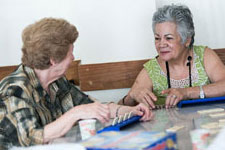Treatment interventions are usually based upon goals set by the family and the healthcare team. Interventions are designed to maximize function by addressing cognitive, mood, and behavioral impairments, as well as to treat any modifiable or reversible causes of impairment (USPSTF, 2020, February 25).
Non-pharmacologic approaches based on family caregiver interactions have the strongest evidence base for the successful management of challenging behaviors. This includes caregiver training and support, increasing the activity of the person with dementia, enhancing communication, reducing the complexity of the physical environment, and simplifying tasks for the person with dementia (Kales et al., 2015).
Caregiver training typically focuses on understanding behavioral responses to discomfort, unmet needs, or attempts to communicate. Creating soothing environments with optimal levels of stimulation and responding to patients in ways that de-escalate problematic behaviors are good management tactics. Distraction, giving patients clear instructions and simple choices, and trying not rewarding challenging behaviors is recommended (Cloak and Khalili, 2022).
The Alzheimer’s Association offers both online educational modules and in-person training classes, which also provide caregivers with professional and peer support. For patients whose behavioral and psychological symptoms occur primarily during personal care, a randomized, multi-site study showed that training caregivers to use a protocol called Bathing without a Battle reduced agitation, bathing time, and antipsychotic use (Cloak and Khalili, 2022).
8.1 Person-Centered Care
The most widely used and recognized person-centered care approach has four key elements:
- valuing people with dementia and those who care for them,
- treating people as individuals,
- looking at the world from the perspective of the person with dementia, and
- a positive social environment (Røsvik and Rokstad, 2020).
Person-centered care has been shown to reduce agitation and improve quality of life in nursing home residents (Ballard et al, 2019). It is designed to be an alternative to or to complement pharmaceuticals in reducing challenging behaviors in individuals with dementia. It has been identified by the Committee on Quality of Health Care as one of the main areas that the healthcare system should address to improve the quality of healthcare, especially long-term care.
8.2 History, Needs, and Well-Being
Well-being is a much larger idea than either quality of life or customer satisfaction. It is based on a holistic understanding of human needs and capacities. Well-being is elusive, highly subjective, and the most valuable of all human possessions.”
Dr. Bill Thomas, What Are Old People For? How Elders Will Save the World
Considering a client’s personal history, preferences, and needs guides caregivers in the development of appropriate, meaningful activities and contributes to the well-being of people accepting care as well as their caregivers. A person’s past medical and social history helps us understand their current needs and behaviors. Person-centered care should be the basis of care for people with dementia.
Understanding a person’s history, especially people with behavioral symptoms of dementia, helps establish priorities related the nature and urgency of interventions. Knowing a person’s history helps caregivers understand symptoms and identify reversible exacerbating factors, including environmental issues, medications, discomfort, substance use, and pre-morbid psychiatric disorders. It also creates a baseline for measuring the effectiveness of treatment (Cloak and Al Khalili, 2022).
This understanding of a client’s needs and wants should be part of a systemic framework for an individual’s plan of care. A flexible plan of care and good case management reduces caregiver fatigue and anxiety, delays institutionalization, and encourages the use of community services (Jerez-Barranco et al., 2022).
The effectiveness of a plan of care is related to information, support and advice, coordination of the care provided and, to a lesser extent, practical help. Case management for patients with dementia should assist both the patient and the underlying system of support (Jerez-Barranco et al., 2022).
A good plan of care offers supportive care in all its stages for both formal and informal caregivers. The former are meant to have in-depth knowledge and competencies to deal with dementia patients, while the latter need to be recognized as indispensable players in dementia care, and both need to form and maintain collaborative relationships to guarantee high-quality care to patients.
In particular, support to caregivers could be considered a win-win solution—beneficial for caregivers, patients, and the healthcare systems. On the opposite side of the spectrum, the unregulated use—and sometimes abuse—of antipsychotic drugs is a no-win situation, detrimental for the health of the patient and a strain on the budget of healthcare systems. Non-pharmacological interventions (including psychosocial/psychological counselling as well as interpersonal and environmental management) should be attempted first, followed by the least harmful medication for the shortest time possible (Guzzon et al., 2023).
8.3 Aligning the Environment to Individual Needs
The built environment is the constructed, physical surroundings (interior and exterior) where a person eats, bathes, sleeps, and interacts socially. There is a profound and direct connection between the environment and how people feel and behave. Buildings thoughtfully designed for the care of people with dementia encourage community, maximize safety, support caregivers, cue specific behaviors and abilities, and redirect unwanted behaviors (Campernel & Brummett, nd).
Among the central principals in the design of dementia-friendly environments are safety and security, simplicity, good structure, and familiarity. Simple, structured, and familiar environments orient people and support wayfinding. Familiarity is related to predictability and continuity; it is also important for creating feelings of being “at home” in addition to supporting social relationships, identity, autonomy, and privacy (Førsund et al., 2018).
A therapeutic environment recognizes that people with dementia are influenced by their surroundings and do better with environments that are individualized, flexible, and designed to support differing functional levels and approaches to care. Homes or buildings thoughtfully designed for the care of people with dementia encourage community, maximize safety, support caregivers, cue specific behaviors and abilities, and redirect unwanted behaviors (Campernel & Brummett, nd).
Unfamiliar, chaotic, or disorganized environments have the opposite effect—they cause anxiety, disorientation, and contribute to behavioral problems. Specific design principles have been shown to reduce unwanted behaviors and enhance a sense of well-being in people with dementia:
- Providing public spaces and places for semi-private interactions.
- Keeping spaces clean and free of odors.
- Providing sunlight and ventilation and providing views to the outside.
- Getting rid of dark nooks and crannies.
- Creating spaces to cue specific behaviors (activity kitchen, art and music therapy area, bistro/bar, rummaging room, library, coffee shop/internet café, quiet room, living room).
The following video from the Social Care Institute for Excellence outlines the elements of a dementia-friendly environment in a care home. The principles apply to adult day care as well.
The Dementia Environment in a Care Home [7:25]
https://www.youtube.com/watch?v=hdbwvmhj5ZQ
8.4 Evidence-Based Intervention Programs
Evidence-based programs that include input from team members and caregivers can reduce or even eliminate agitated or aggressive behaviors. Staff education is particularly important and can reduce behavioral outbursts and decrease restraint use.
“Multimodal” interventions use different tactics and activities based upon the needs of the person with dementia. This approach utilizes the skills and services of multiple professions, which ideally form a team to assess and implement approaches for each individual under their care.
8.4.1 Psychosocial and Environmental Interventions
Cognitive stimulation, music therapy, exercise, massage, therapeutic touch, acupressure, and tactile massage can be successful for treating challenging behaviors. Individual behavioral therapy, bright light therapy, aromatherapy, animal therapy, multisensory stimulation,* Montessori activities, and individualized, person-centered care are also recommended (Burns et al., 2012).
*Multisensory stimulation: a controlled multisensory environment uses light, sound, scents, and music to initiate sensations. These have both relaxing and activating effects on the various parts of the brain related to sensory perception. The specific design directs and arranges the stimuli; it creates interest, brings back memories and guides relationships.
8.4.2 Cognitive Therapy
Cognitive stimulation, uses a variety of psychosocial and cognition-focused interventions, is widely used in dementia care. Cognitive stimulation program are typically provided in a group setting, where participants engage in various activities and discussions to improve their overall cognitive and social performance (Ryan et al., 2023).
Cognitive stimulation therapy (CST) was developed for people with mild to moderate dementia. It aims to enhance cognitive and social functioning using group therapy incorporating reality orientation, reminiscing, socializing, and actively stimulating participants. There is evidence that it can improve cognition in people with mild to moderate dementia over and above any medication effects (Binns et al., 2020).
8.4.3 Social Participation and Social Identity
People with dementia describe losses that affect their independence and ability to contribute to society. Loss of autonomy, control, and connection, memory problems, and the unpredictable progression of the disease lead to worry and anxiety. People report feeling stigmatized, no longer normal, embarrassed, or stupid. Dementia threatens their identity and sense of worth and changes their roles and the relationship to others (Bjørkløf et al, 2019).

A man enjoying a familiar activity. Southeastern Veterans Center by padmva is licensed under CC BY-NC-ND 2.0.
Loss of social contact and feeling unable to participate in meaningful activities leads to loneliness, isolation, emptiness, and boredom. The decline in function and abilities has a significant impact on daily life and some express that life loses purpose, and that happiness is gone (Bjørkløf et al, 2019).
Reduced social participation can lead to the loss of a person’s social identity derived from a profession, job, or membership in a group. For example, an older person who identifies as a “care provider” may not want to attend a support group for fear that he or she would become a “care recipient” (Goll et al., 2015).
Some people try to uphold independent and youthful identities. They avoid groups for older people in case they become identified as “old” and thus stigmatized. They emphasize their self-sufficiency, distinguish themselves from “old” people whom they describe as dependent and decrepit, and avoid opportunities for support (Goll et al., 2015).
Talking therapies like CBT can enhance late-life social participation. However, since lonely and socially fearful older people are unlikely to engage in therapy without significant support, a more effective strategy might add CBT principles in pre-existing community groups. For example, organizations might challenge fears about attendance by emphasizing the friendliness of groups, implementing a “buddy” system for new members, normalizing social fears, and facilitating gradual steps towards participation (Goll et al., 2015).
8.4.4 The Benefits of Respite Care
Respite care is an often-overlooked intervention that benefits people with dementia as well as their caregivers. It provides caregivers with a break, reduces caregiver stress, and provides stimulation and social interaction for the person with dementia. When people with dementia attend a day care program, caregivers report decreased behavioral problems.

Individual activities in adult day care setting. Source: ADEAR, 2014. From: http://www.nia.nih.gov/alzheimers/
publication/2013-2014-alzheimers-disease-progress-report/caregiving-and-alzheimers
While some supportive services for family caregivers are available, many caregivers are not aware of them—especially individuals who are new to the family caregiving role. By the time they learn about these services they often find they cannot access them for a host of reasons such as cost, scheduling, distance from home or work, lack of availability of childcare or respite services, or services are not culturally competent (RAISE, 2022).
There has been a call for increased support for home and community-based services provided through Medicaid. Additionally, adding long-term services and benefits to Medicare for respite, adult day services, and home modifications is being discussed. Increasing funding for programs that provide community-based support for people with dementia and their family caregivers, programs for professional caregivers who support people with dementia, and the VA’s Caregiver Support Program is crucial (RAISE, 2022).
Despite the benefits to the caregiver, daycare services are underutilized. Caregivers may feel guilty or may find it difficult to hand over responsibility for their loved one to another caregiver—even for a short time. Respite care may not be provided in a culturally competent way, which considers the needs and preferences of diverse cultural and ethnic groups. Add to this the cost of adult day services and the lack of available services, especially in rural and minority communities.
8.4.5 Exercise and Physical Activity
Physical activity may be a protective factor against cognitive decline. Several small studies have demonstrated significant benefits for Alzheimer’s clients on cognition and also on quality of life and depression. Physical activity may also be beneficial in clients already suffering Alzheimer’s dementia, improving clinical symptoms (Holthoff et al., 2015).

Man exercising on an upper extremity bike. Southeastern Veterans Center by padmva is licensed under CC BY-NC-ND 2.0.
Walking, resistance training, and seated exercises that focus on improving aerobic endurance, strength, balance, and flexibility have beneficial effects on physical function in individuals with cognitive impairment and dementia. Exercise improves a person’s ability to perform basic activities of daily living such as eating, dressing, bathing, using the toilet, and transferring from bed to chair.
At the University of California at San Francisco, a group exercise program for individuals with mild-to-moderate dementia called Preventing Loss of Independence through Exercise (PLIÉ) has had some promising results. The seven guiding principles of the program are (Chao et al, 2021):
- repetition with variation
- progressive, functional movement
- slow pace and step-by-step instruction
- participant-centered goal orientation
- body awareness, mindfulness, and breathing
- social interaction
- positive emotions
Consistent with the relationship-centered approach of integrative medicine, PLIÉ instructors are taught to incorporate these guiding principles in a flexible manner based on participants’ in-the-moment needs and experiences, rather than having a scripted “package of care” (Chao et al, 2021).
The results suggest that PLIÉ may be associated with improvements in physical performance, cognitive function, and quality of life in individuals with mild to moderate dementia as well as reduced caregiver burden when compared with an existing program that involved daily chair-based exercises. The improvement observed with PLIÉ was substantially larger than what has been observed with currently approved dementia medications and affects a broader range of outcomes (Barnes et al., 2015).
8.4.6 Animal-Assisted Therapy

Pet therapy visit by K9 Playgroups is licensed under CC BY-NC-ND 2.0.
Animal-assisted therapy is an intervention in which animals meeting specific criteria become an integral part of the treatment process. Animal-assisted therapy improves a person’s mental and physical health. It is relaxing, reduces the feeling of anxiety, contributes to the lowering of loneliness, and helps in the recall of memories. In the area of physical health, animal-assisted therapy helps to reduce blood pressure and improves cardiovascular health, decreases the number of medications, and reduces physical pain (Klimova et al., 2019a).
For individuals with dementia, animal-assisted therapy (Klimova et al., 2019a):
- Contributes to slightly higher physical activity; people can pet the animal, or if able, go for a walk.
- Relieves so-called sundown syndrome, which manifests itself in increased agitation, restlessness, disorientation, and aggressive behavior.
- Improves short-term memory and communication skills.
- Enhances eating habits.
- Reduces loneliness.
8.5 Intervening Using the Problem-Solving Approach
Behavioral therapy using antecedent-behavior-consequence (ABC)—also called the problem-solving approach—may provide sustained improvements in behavior. One meta-analysis found that behavioral management techniques that focus on individual client’s behavior and individually oriented techniques provided longer lasting (several months) positive effects on behavior when compared with placebo (Nowrangi et al., 2015).
In this approach, caregivers are encouraged to problem solve—to look for and understand the root cause of a behavior. Intervention includes solving problems within the environment, managing medication issues, and brainstorming with other caregivers. The problem-solving approach encourages caregivers and healthcare workers to identify critical points for intervention based on observing the antecedent, behavior, and consequence (A, B, C) of a challenging behavior.
- Antecedent—what caused the behavior?
- Behavior—what is the behavior?
- Consequence—what are the consequences of the behavior?
The problem-solving approach is particularly effective when successful strategies are shared by staff, caregivers, and family members and used to uncover the cause of a particular behavior. This method helps staff and caregivers understand when and how often a behavior occurs and offers the opportunity for discussion and planning.
In a Norwegian study, researchers worked with healthcare workers in a small, rural nursing home to identify the effectiveness of the problem-solving approach in addressing challenging behaviors in residents with dementia. At the start of the study the care workers described what they understood about—and how they responded to—challenging behaviors. Most regarded challenging behaviors as a symptom of the resident’s dementia, including physical attacks, such as hitting, spitting, and pinching (Lykkeslet et al., 2014).
Prior to the study, the care workers shared their understanding of why certain disruptive behaviors occurred. During the first year of the study the staff reported that, as a result of being encouraged to look for the cause of a behavior, they began to get into the habit of searching for meaning in patients’ behaviors and gradually began to change their attitude toward the people they were caring for. Health workers said they were learning to see peculiar behavior more as a result of a challenging situation than as a symptom of a difficult patient (Lykkeslet et al., 2014).
One of the care workers gave an example of a patient who did not want to eat her food:
She refuses to open her mouth, so it is impossible to feed her. Any new caregiver who helps her will often fail. When I assist her, I always start by touching her hand, holding her hand, and then she gradually starts to eat.
The care worker added that this patient might have misunderstood the situation and therefore did not trust the new caregiver, who had to spend some time building trust (Lykkeslet et al., 2014).
You cannot go straight to the task—she needs some preparation to understand what is going on and what she has to do.
By observing the patient’s reactions, the care worker understood that the patient needed time to prepare. She needed to understand that the situation was a meal and that the care worker wished her well (Lykkeslet et al., 2014).
Another care worker said she began to understand patients with poor verbal language.
We try to read their body language. Perhaps she is in pain. . . sometimes she can tell us. . . other times we get no answer.
Sometimes the care workers saw the behavior as a response to a critical situation: “because he is vulnerable, he becomes angry.” As the study progressed, researchers began to observe changes in the care provider’s attitudes and approach to activities. They noted that when the caregivers experienced a situation as challenging, they more frequently started to reflect on the patients’ needs (Lykkeslet et al., 2014).
